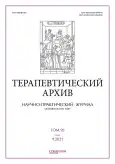Takotsubo syndrome after palliative transcatheter treatment of acquired aortic stenosis in patient with congenital ventricular septal defect. Case report
- Authors: Komlev A.E.1, Muksinova M.D.1, Saidova M.A.1, Kurilina E.V.1, Imaev T.E.1
-
Affiliations:
- Myasnikov Institute of Clinical Cardiology, National Medical Research Center of Cardiology
- Issue: Vol 93, No 9 (2021)
- Pages: 1078-1085
- Section: Case reports
- URL: https://journals.rcsi.science/0040-3660/article/view/82976
- DOI: https://doi.org/10.26442/00403660.2021.09.201031
- ID: 82976
Cite item
Full Text
Abstract
The authors report the clinical case of secondary Takotsubo syndrome developed after transcatheter aortic valve replacement that was performed in compassionate manner in female patient with combination of congenital ventricular septal defect and acquired severe aortic stenosis. In the team’s view, Takotsubo syndrome was triggered with profound changes of intracardial hemodynamics subsequent to iatrogenic impairment of preexisting interventricular shunt.
Full Text
##article.viewOnOriginalSite##About the authors
Alexey E. Komlev
Myasnikov Institute of Clinical Cardiology, National Medical Research Center of Cardiology
Author for correspondence.
Email: pentatonika@bk.ru
ORCID iD: 0000-0001-6908-7472
кардиолог отд. сердечно-сосудистой хирургии
Russian Federation, MoscowMarina D. Muksinova
Myasnikov Institute of Clinical Cardiology, National Medical Research Center of Cardiology
Email: pentatonika@bk.ru
ORCID iD: 0000-0001-6516-5322
кардиолог отд. сердечной недостаточности и заболеваний миокарда
Russian Federation, MoscowMarina A. Saidova
Myasnikov Institute of Clinical Cardiology, National Medical Research Center of Cardiology
Email: pentatonika@bk.ru
ORCID iD: 0000-0002-3233-1862
д-р мед. наук, проф., рук. отд. ультразвуковых методов исследования
Russian Federation, MoscowElla V. Kurilina
Myasnikov Institute of Clinical Cardiology, National Medical Research Center of Cardiology
Email: pentatonika@bk.ru
ORCID iD: 0000-0002-3208-534X
врач-патологоанатом, зав. патологоанатомическим отд-нием
Russian Federation, MoscowTimur E. Imaev
Myasnikov Institute of Clinical Cardiology, National Medical Research Center of Cardiology
Email: pentatonika@bk.ru
ORCID iD: 0000-0002-5736-5698
д-р мед. наук, сердечно-сосудистый хирург, гл. науч. сотр. отд. сердечно-сосудистой хирургии
Russian Federation, MoscowReferences
- Prasad A, Dangas G, Srinivasan M, et al. Incidence and angiographic characteristics of patients With apical ballooning syndrome (takotsubo/stress cardiomyopathy) in the HORIZONS-AMI trial. Cathet Cardiovasc Intervent. 2013;83(3):343-8. doi: 10.1002/ccd.23441
- Bybee K, Prasad A, Barsness G, et al. Clinical characteristics and Thrombolysis In Myocardial Infarction frame counts in women with transient left ventricular apical ballooning syndrome. Am J Cardiol. 2004;94(3):343-6. doi: 10.1016/j.amjcard.2004.04.030
- Redfors B, Vedad R, Angerås O, et al. Mortality in takotsubo syndrome is similar to mortality in myocardial infarction – A report from the SWEDEHEART registry. Int J Cardiol. 2015;185:282-9. doi: 10.1016/j.ijcard.2015.03.162
- Templin C, Ghadri J, Diekmann J, et al. Clinical Features and Outcomes of Takotsubo (Stress) Cardiomyopathy. N Engl J Med. 2015;373(10):929-38. doi: 10.1056/nejmoa1406761
- Y-Hassan S. Clinical features and outcome of epinephrine-induced takotsubo syndrome: Analysis of 33 published cases. Cardiovasc Revasc Med. 2016;17(7):450-5. doi: 10.1016/j.carrev.2016.07.005
- Abraham J, Mudd J, Kapur N, et al. Stress Cardiomyopathy After Intravenous Administration of Catecholamines and Beta-Receptor Agonists. J Am Coll Cardiol. 2009;53(15):1320-5. doi: 10.1016/j.jacc.2009.02.020
- Ansari U, El-Battrawy I, Fastner C, et al. Clinical outcomes associated with catecholamine use in patients diagnosed with Takotsubo cardiomyopathy. BMC Cardiovasc Disord. 2018;18(1). doi: 10.1186/s12872-018-0784-6
- Mitchell A, Marquis F. Can takotsubo cardiomyopathy be diagnosed by autopsy? Report of a presumed case presenting as cardiac rupture. BMC Clin Pathol. 2017;17(1). doi: 10.1186/s12907-017-0045-0
- Manes A, Palazzini M, Leci E, et al. Current era survival of patients with pulmonary arterial hypertension associated with congenital heart disease: a comparison between clinical subgroups. Eur Heart J. 2013;35(11):716-24. doi: 10.1093/eurheartj/eht072
- Galiè N, Humbert M, Vachiery J, et al. 2015 ESC/ERS Guidelines for the diagnosis and treatment of pulmonary hypertension. Eur Heart J. 2015;37(1):67-119. doi: 10.1093/eurheartj/ehv317
- Prasad A, Lerman A, Rihal C. Apical ballooning syndrome (Tako-Tsubo or stress cardiomyopathy): A mimic of acute myocardial infarction. Am Heart J. 2008;155(3):408-17. doi: 10.1016/j.ahj.2007.11.008
- Ghadri J, Wittstein I, Prasad A, et al. International Expert Consensus Document on Takotsubo Syndrome (Part I): Clinical Characteristics, Diagnostic Criteria, and Pathophysiology. Eur Heart J. 2018;39(22):2032-46. doi: 10.1093/eurheartj/ehy076
- Harhash A, Koulogiannis K, Marcoff L, et al. Cardiomyopathy After Transcatheter Aortic Valve Replacement. JACC Cardiovasc Interv. 2016;9(12):1302-4. doi: 10.1016/j.jcin.2016.04.017
- Floras J, Ponikowski P. The sympathetic/parasympathetic imbalance in heart failure with reduced ejection fraction. Eur Heart J. 2015;36(30):1974-82. doi: 10.1093/eurheartj/ehv087
- Madias J. Cardiac arrest-triggered takotsubo syndrome vs. takotsubo syndrome complicated by cardiac arrest. Int J Cardiol. 2016;225:142-3. doi: 10.1016/j.ijcard.2016.09.090
- Madias C, Fitzgibbons T, Alsheikh-Ali A, et al. Acquired long QT syndrome from stress cardiomyopathy is associated with ventricular arrhythmias and torsades de pointes. Heart Rhythm. 2011;8(4):555-61. doi: 10.1016/j.hrthm.2010.12.012
- Migliore F, Zorzi A, Perazzolo Marra M, et al. Myocardial edema as a substrate of electrocardiographic abnormalities and life-threatening arrhythmias in reversible ventricular dysfunction of takotsubo cardiomyopathy: Imaging evidence, presumed mechanisms, and implications for therapy. Heart Rhythm. 2015;12(8):1867-77. doi: 10.1016/j.hrthm.2015.04.041
- Gili S, Cammann V, Schlossbauer S, et al. Cardiac arrest in Takotsubo syndrome: results from the InterTAK Registry. Eur Heart J. 2019;40(26):2142-51. doi: 10.1093/eurheartj/ehz170
- Lyon A, Bossone E, Schneider B, et al. Current state of knowledge on Takotsubo syndrome: А Position Statement from the Taskforce on Takotsubo Syndrome of the Heart Failure Association of the European Society of Cardiology. Eur J Heart Fail. 2015;18(1):8-27. doi: 10.1002/ejhf.424
Supplementary files


















